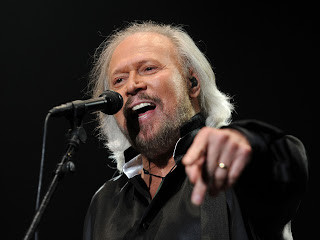The Bee Gees’ “You Should Be Dancing” is more than just a disco anthem; it’s a masterclass in rhythm, vocal layering, and sheer musical ingenuity. Forty years after it topped the US charts, this track continues to fill dance floors and inspire awe among musicians and fans alike. In a recent interview, Barry Gibb delved into the captivating backstory of this iconic song, revealing the intricate process behind its creation. This article explores the fascinating details he shared, offering a deeper appreciation for the song’s enduring appeal and the lyrical energy that drives its irresistible groove.
 Barry Gibb in 2016, showcasing his enduring musical legacy.
Barry Gibb in 2016, showcasing his enduring musical legacy.
Gibb’s insights provide a unique window into the Bee Gees’ creative process during their disco era. He recounts how “You Should Be Dancing” wasn’t a song that came easily but was sculpted and refined over two weeks of intense studio work. The pursuit of rhythmic perfection was central to their vision, leading them to experiment with Latin influences that were naturally present in their Miami environment. This fusion of styles became a signature element of the Bee Gees’ sound, perfectly exemplified in the infectious rhythm of “You Should Be Dancing.”
The quest for the perfect beat involved multiple takes and relentless tweaking. Gibb reveals, “I remember that we cut the track at least four times. That we fixed things over and over again throughout that two weeks that it took to put that altogether.” This dedication to detail is evident in the final product, a song layered with intricate percussion, including the contribution of Stephen Stills, who added his magic to the track in the early hours of the morning. This collaborative and experimental approach highlights the Bee Gees’ commitment to pushing musical boundaries.
One of the most surprising revelations from Gibb’s interview is his subtle vocal contribution during the iconic trumpet solo. He confesses to singing along in falsetto with the instrumental melody, a hidden layer within the rich tapestry of the song. This detail underscores the Bee Gees’ innovative approach to arrangement and their willingness to experiment with vocal textures beyond the lead melody. As Gibb explains, “With You Should Be Dancing it was the sudden emergence of having as many tracks as you wanted. So you would always add something else that made it unusual.” This freedom to layer sounds allowed them to create a sonic landscape that was both complex and instantly captivating.
The mixing process of “You Should Be Dancing” was as demanding as its recording. Gibb vividly describes the collaborative effort, “…it took 10 of us to mix that song. [As in], 10 at the board. You couldn’t update anything, there was no such thing. So you had to do the whole mix at once with everybody moving faders.” This pre-digital era approach demanded precision and teamwork, a testament to the dedication of the production team in capturing the song’s energy and detail in a single live mix. Gibb’s specific role in controlling the echo repeat on the line “Whatcha’ doin’ on ya’ back?” further illustrates the meticulous attention given to every element of the track.
While acknowledging the effort and innovation poured into “You Should Be Dancing,” Gibb maintains a humble perspective on predicting a song’s success. He notes, “Well I don’t think you can ever say that about any song. I think you can look at each other and go, “this is great. This is special.”” However, he admits there was a special feeling during the creation of “You Should Be Dancing,” driven by the desire to create music that resonated with the burgeoning dance culture. This intention, combined with their meticulous craftsmanship, undoubtedly contributed to the song’s enduring popularity and its status as a defining track of the disco era.
In conclusion, Barry Gibb’s reflections on “You Should Be Dancing” offer a fascinating glimpse behind the curtain of a timeless hit. From its rhythmic experimentation and layered vocals to its demanding mixing process, every aspect of the song’s creation was a testament to the Bee Gees’ artistry and dedication. Understanding the backstory enhances our appreciation for the song’s infectious energy and the lyrical invitation to move, solidifying its place as a cornerstone of disco music and a beloved classic for generations.

